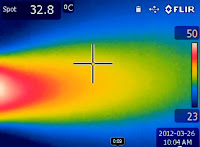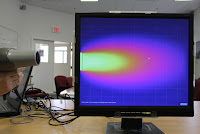 |
| IR: Watch the YouTube video |
Augmented reality (AR) presents a live view of the real world whose elements are augmented by computer-generated data such as sound or graphics. The technology promises to enhance the user’s current perception of reality. AR is considered as an extension of virtual reality (VR). But unlike VR that replaces the real world with a simulated one, AR bridges and takes advantage of the real world and the simulated world.
Augmentation is conventionally in real-time and in semantic context with environmental elements. With the help of AR technology, the information about the surrounding real world of the user becomes digitally manipulable. Artificial information about the environment and its objects can be overlaid on the real world to achieve seamless effects and user experiences.
Our NSF-funded Mixed-Reality (MR) Labs Project has set out to explore how AR/MR technologies can support “augmented inquiry” to help students learn abstract concepts that cannot be directly seen or felt in purely hands-on lab activities.
 |
| AR: Watch the YouTube video |
One of the first classes of prototype we have built is what we call “Augmented Reality Thermal Imaging.” The concepts related to heat and temperature are somehow difficult to some students because thermal energy is invisible to the naked eye. Thermal energy can now be visualized using infrared (IR) imaging. But we have developed AR technology that provides another means of “seeing” thermal energy and its flow.
The first image in this post shows an IR image of a poster board heated by a hair dryer. The second image shows a demo of AR thermal imaging: When a hair dryer blows hot air to a liquid crystal display (LCD), the AR system reacts as if hot air could flow into the screen and leave a trace of heat on the screen, just like what we see in the IR image above. You may click the links below the images to watch the recorded videos.
The tricky part of MR Labs is that, in order to justify the augmentation of a computer simulation to a physical activity, the simulation should be a good approximation of what happens in the real world. We used our computational fluid dynamics (CFD) program, Energy2D, to accomplish this. There are many more demos of MR Labs using Energy2D, which can be viewed at this website.